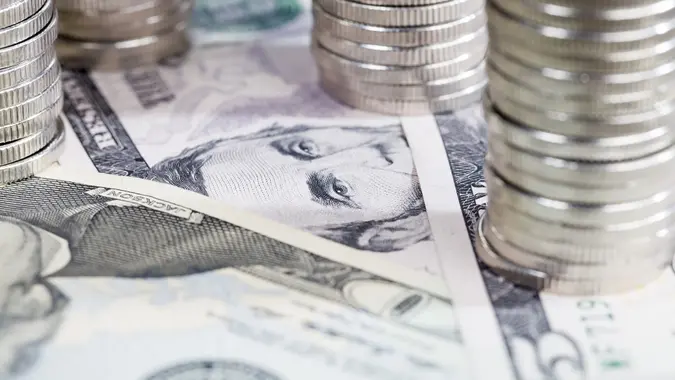How To Calculate CD Interest: A Step-by-Step Guide

Commitment to Our Readers
GOBankingRates' editorial team is committed to bringing you unbiased reviews and information. We use data-driven methodologies to evaluate financial products and services - our reviews and ratings are not influenced by advertisers. You can read more about our editorial guidelines and our products and services review methodology.

20 Years
Helping You Live Richer

Reviewed
by Experts

Trusted by
Millions of Readers
CDs are a low-risk investment option that allows your money to grow at a fixed interest rate over a specific period. If you’re considering opening a certificate of deposit (CD) or already have one, you might be wondering how to calculate CD interest and estimate how much you’ll earn over time.
In this guide, we’ll explain how CD interest is calculated, break down simple versus compound interest and provide real-life examples to help you understand how much you can earn.
How To Calculate CD Interest
CDs earn compound interest, making them attractive to risk-averse investors. Compounding means that CDs earn interest periodically, according to whatever compounding frequency the bank uses, throughout the term of the CD. The interest is based on the entire account balance, including interest previously earned.
Since CDs typically have a fixed interest rate, you can accurately determine how much you’ll earn when your CD matures.
Compared with simple interest, compound interest grows your money faster. The following formula calculates the value of your CD at the end of the term. It does that by calculating and applying compound interest.
A = P(1+r/n)(nt)
- A is your CD’s worth at the end of the term, including the amount you put in plus compound interest.
- P is the principal, the amount you deposited into the CD.
- R is the rate, or annual rate of interest, expressed as a decimal. If the interest rate is 2.5%, r is 0.025.
- n is the number of times that interest is compounded per period. Most CDs compound interest daily, so n = 365. Check with your bank to verify the interest is compounded daily.
- t is time or the number of periods until the maturity date.
Key Terms To Know When Calculating CD Interest
Interest formulas for CDs have several variables. Understanding what they are is key to making sense of the calculations.
As you dive into the formulas, it’s important to understand these key CD terms:
- Principal: The initial amount you deposit in the CD.
- Interest Rate (APY or APR): The percentage your money earns over time.
- Term Length: The duration (e.g., six months, one year, five years) you agree to keep your money in the CD.
- Compounding Frequency: How often the interest is added to your balance (daily, monthly, quarterly or annually).
The way interest is calculated significantly impacts your earnings, especially with different compounding frequencies.
How To Calculate Simple Interest on a CD
Simple interest is the interest rate without compounding, meaning it’s applied just once and only to the principal. So you don’t need a formula to figure out what it is, but you do need a formula to see how it affects your CD principal.
Here’s the formula for calculating simple interest:
A = P(1+rt)
- A is the value of the CD at the end of the term
- P is the principal, which is your initial deposit
- R is the interest rate
- T is the number of periods
Example: Take a look at how a deposit of $10,000 would grow in a one-year CD with 2.5% simple interest. Here’s the calculation:
- A = 10,000 (1+(0.025 * 1) = 10,250
- A = $10,250
How To Calculate Compound Interest on a CD: An Example
Take a look at how a deposit of $10,000 would grow in a five-year CD at 2.5% interest, compounded daily.
Here’s the calculation:
- A = 10,000 (1+0.025 / 365) ^ (365*5)
Using the correct order of operations, here’s the process:
- A = 10,000 (1+0.000068493150685)^(365*5)
- A = 10,000 (1.000068493150685)^(365*5)
- A = 10,000 (1.000068493150685)^1825
- A = 10,000 (1.133143602492102334771122378642)
- A = 11,331.44 (rounded)
The total at the end of five years would be about $11,331.44. Because you deposited $10,000, you earned $1,331.44 in interest.
How much does a $10,000 CD make in a year? If your interest rate is 2.5% and your term length is one year, you would earn around $266.29 in interest. Of course, your earnings would depend on the interest rate, term length and other CD term conditions.
The Effect of Compounding Frequency on CD Interest
To better understand how compounding affects interest earnings, let’s compare a $5,000 CD at 3% for three years with different compounding frequencies.
| Compounding Frequency | Total Balance After 3 Years | Total Interest Earned |
|---|---|---|
| Annually (1x/year) | $5,463 | $463 |
| Quarterly (4x/year) | $5,469 | $469 |
| Monthly (12x/year) | $5,472 | $472 |
| Daily (365x/year) | $5,475 | $475 |
While daily compounding earns the most, the difference compared to monthly or quarterly compounding is small.
The more often interest is compounded, the faster your CD grows. While most CDs compound interest daily and credit your account once a month, other savings products might compound less frequently — monthly, quarterly or annually, for example.
Using the previous example of a $10,000 five-year CD, here’s how much interest you’d earn with daily compounding and how much you’d earn if interest was compounded once a month.
- Daily compounding: You’d earn $1,331.44 in interest after five years, and your CD would be worth $11,331.44
- Monthly compounding: You’d earn $1,330.01 in interest after five years, and your CD would be worth $11,330.01
CD Interest Calculator
Understanding how interest formulas work gives you valuable insight into the growth potential of CDs. But you can run the numbers without doing the calculations manually.
A CD interest calculator does the work for you and makes it easy to experiment with different variables to find the combination of rate and term that works best for you.
To help you work things out with your CD, here’s a reliable online calculator.
Comparing CD Interest Calculations Across Terms
Here’s an at-a-glance look at how your interest earnings vary from one CD term and compounding frequency to another. It uses a $10,000 CD at 2.5% interest in the calculation.
| CD Term | Interest Earned With Daily Compounding | Interest Earned With Monthly Compounding |
|---|---|---|
| 12 months | $253.14 | $252.88 |
| 3 years | $778.81 | $778.00 |
| 5 years | $1,331.44 | $1,330.01 |
| 10 years | $2,840.14 | $2,836.92 |
How To Maximize Your CD Interest
To make the most of your CD earnings:
- Compare Rates: Look for the highest interest rates before opening the CD.
- Choose the Best Term Length: Consider how long you can leave your money untouched.
- Opt for Frequent Compounding: Daily or monthly compounding earns more over time.
- Avoid Early Withdrawals: Withdrawing early results in penalties that reduce earnings.
Final Thoughts To GO
Calculating CD interest helps you make smarter investment decisions by understanding how much you’ll earn over time. Compound interest can significantly boost your savings, especially with longer terms and frequent compounding.
Now that you understand how to calculate the interest earned on a CD, you can compare the rates offered by different banks and choose the one that best fits your needs.
CD interest rates vary by the length of time, with 12-month CDs typically earning the highest rates. Rates tend to be higher for larger deposits, with jumbo CDs usually offering the highest rates, at least on select terms. To make an informed decision about which type of CD is best for you, consider its value and what financial institution offers the best CD for you.
Heather Altamirano and Karen Doyle contributed to the reporting for this article.
FAQs: How To Calculate CD Interest
Here are the answers to some of the most frequently asked questions regarding CD accounts.- How do I calculate interest with daily compounding?
- This calculator from the U.S. Securities and Exchange Commission does the calculation for you. Just enter the following information where indicated:
- Your initial deposit
- Monthly contributions (if applicable)
- Number of years before you withdraw the money
- Interest rate
- "Daily" as the compounding frequency.
- This calculator from the U.S. Securities and Exchange Commission does the calculation for you. Just enter the following information where indicated:
- Can I calculate CD interest manually, or should I use an online calculator?
- You can calculate it manually, but it's often better to use an online calculator. The formula is complicated and has several steps.
- What's the difference between APY and APR in a CD interest calculation?
- APR, for annual percentage rate, is the effective rate you pay on money you owe. It's unrelated to CD and other savings interest, which is money you receive. APY, for annual percentage yield, is the effective rate of interest you earn on your CD after accounting for compounding. You don't enter APY as the rate when you're calculating compound interest, however. The formula calculates it based on the interest rate, compounding frequency and the number of times interest will be compounded.
- How does early withdrawal affect CD interest?
- Unless you have a no-penalty CD that allows early withdrawals, withdrawing your money before the CD matures results in a penalty of a certain amount of interest. Your CD account disclosure or agreement will list the penalty, but typical penalties are anywhere from seven days to one year's worth of simple interest, depending on the CD term.
Data is accurate as of March 31, 2025, and is subject to change.
Editorial Note: This content is not provided by any entity covered in this article. Any opinions, analyses, reviews, ratings or recommendations expressed in this article are those of the author alone and have not been reviewed, approved or otherwise endorsed by any entity named in this article.
Our in-house research team and on-site financial experts work together to create content that’s accurate, impartial, and up to date. We fact-check every single statistic, quote and fact using trusted primary resources to make sure the information we provide is correct. You can learn more about GOBankingRates’ processes and standards in our editorial policy.
- Investor.gov "Certificates of Deposit (CDs)"
- Federal Deposit Insurance Corporation "National Rates and Rate Caps"
- Investor.gov "What is compound interest?"
- Investor.gov "Compound Interest Calculator"
- Consumer Financial Protection Bureau "How does compound interest work?"
- Fidelity "What is compound interest?"
 Written by
Written by  Edited by
Edited by 

























